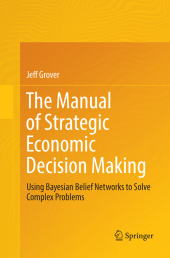 Neuerscheinungen 2018Stand: 2020-02-01 |
Schnellsuche
ISBN/Stichwort/Autor
|
Herderstraße 10
10625 Berlin
Tel.: 030 315 714 16
Fax 030 315 714 14
info@buchspektrum.de |

Jeff Grover
The Manual of Strategic Economic Decision Making
Using Bayesian Belief Networks to Solve Complex Problems
Softcover reprint of the original 1st ed. 2016. 2018. xxviii, 260 S. 4 SW-Abb., 51 Farbabb., 45 Farbtab
Verlag/Jahr: SPRINGER, BERLIN; SPRINGER INTERNATIONAL PUBLISHING 2018
ISBN: 3-319-83937-3 (3319839373)
Neue ISBN: 978-3-319-83937-0 (9783319839370)
Preis und Lieferzeit: Bitte klicken
This book is an extension of the author´s first book and serves as a guide and manual on how to specify and compute 2-, 3-, and 4-Event Bayesian Belief Networks (BBN). It walks the learner through the steps of fitting and solving fifty BBN numerically, using mathematical proof. The author wrote this book primarily for inexperienced learners as well as professionals, while maintaining a proof-based academic rigor.
The author´s first book on this topic, a primer introducing learners to the basic complexities and nuances associated with learning Bayes´ theorem and inverse probability for the first time, was meant for non-statisticians unfamiliar with the theorem-as is this book. This new book expands upon that approach and is meant to be a prescriptive guide for building BBN and executive decision-making for students and professionals; intended so that decision-makers can invest their time and start using this inductive reasoning principle in their decision-making processes. It highlights the utility of an algorithm that served as the basis for the first book, and includes fifty 2-, 3-, and 4-event BBN of numerous variants.
1. Introduction
1.1 Bayes´ Theorem: An Introduction
1.2 Protocol
1.3 Data
1.4 Statistical Properties of Bayes´ Theorem
1.5 Base Matrices
1.5.1 Event A Node 2. Base Matrices
2.1 Event A Node
2.1.1 Event A Node-Prior Counts
2.1.2 Module A-Prior Probabilities
2.2 Event B
2.2.1 Event B Node-Likelihood Counts
2.2.2 Module B Node
2.2.3 Event B Node-Counts
2.2.4 Event B Node-Likelihood Probabilities
2.3 Event C Node
2.3.1 Event C Node-Counts
2.3.2 Event C Node-Likelihood Probabilities
2.3.3 Event C Node-Counts
2.3.4 Event C Node-Likelihood Probabilities
2.3.5 Event C Node-Counts
2.3.6 Event C Node-Likelihood Probabilities
2.3.7 Event C Node-Counts
2.3.8 Event C Node-Probabilities
2.4 Event D Node
2.4.1 Event D Node-Counts
2.4.2 Event D Node-Likelihood Probabilities
2.5 Event D Node-Counts
2.5.1 Event D Node-Likelihood Probabilities
2.5.2 Event D Node-Counts
2.5.3 Event D Node-Likelihood Probabilities
2.5.4 Event D Node-Counts
2.5.5 Event D Node-Likelihood Probabilities
2.5.6 Event D Node-Counts
2.5.7 Event D Node-Likelihood Probabilities
2.5.8 Event D Node-Counts
2.5.9 Event D Node-Likelihood Probabilities
2.5.10 Event D Node-Counts
2.5.11 Event D Node-Likelihood Probabilities 3. 2-Event 1-Path BBN
3.1 [ A ] [ B ]
3.1.1 2-Event BBN Proof
3.1.2 BBN Specification 4.3-Event 2-Path BBNs
4.1 [ AB AC ]
4.1.1 Proof
4.1.2 BBN Specification
4.2 [ AC B C ]
4.2.1 Proof 4.2.2 BBN Specification
4.3 [ AB BC ]
4.3.1 Proof
4.3.2 BBN Specification 5. 3-Event 3-Path BBNs
5.1 3-Paths-[ AB AC BC ]
5.1.1 Proof
5.1.2 BBN Probabilities


